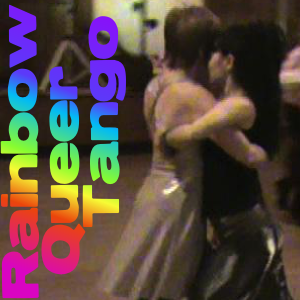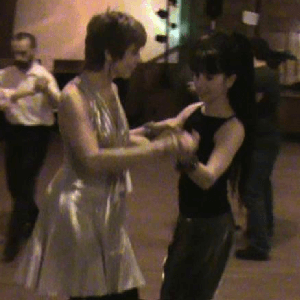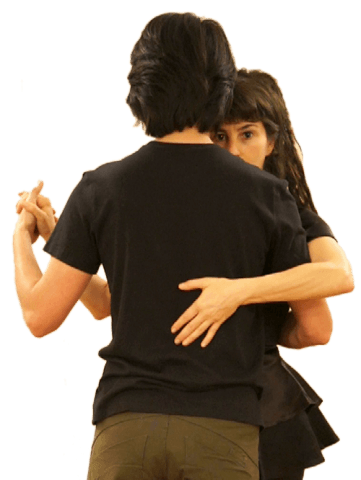Last night at my beautiful milonga, Jewel Lab, in Sydney, the usual happened. I got so tired that I couldn’t sit up, let alone stand up and dance.
I tried to say it was jet lag, but the truth is that it happened every week when I was living here, running Jewel Lab. I used to believe it was the unpleasant stress of DJing, which I hated, but I’ve retired from that now. DJ Nick does a great job at Jewel Lab. I also believed it had to do with the variabilities of a milonga. As the host I put lots of power, and sometimes it’s successful, but if it rains or whatever, then it’s too small. But last night I was more like a special guest than a host. I thought, maybe I’m just tired from teaching 4 hours today. But a few weeks ago I taught for 7 hours and then enjoyed a high-power night at a milonga.
All my reasons fail, leaving me with just one: Women’s tango hunger.
The same thing happens to me at Roberto’s Sunday milonga in Greifswald. I arrive happy, and I’m so glad to see everyone. I dance a couple of tandas. Then I become totally wiped out. I can barely sit up in my chair. This doesn’t happen to me as a guest at a milonga. And in general I rarely lack for power.
Here’s what I think is happening: I can feel the women’s tango hunger. I know that hunger for tango ecstasy. I know it as an addiction, as a wound, as a sweet balm. I know that dancing with them won’t be enough. I can give them my best and they will still be hungry.
If I have any responsibility for the event, this sensation drains me to the point that I desperately want to lay down on the floor and go to sleep.
I feel sad that I can’t be happy and energetic at Jewel Lab during my farewell visit here. It’s so beautiful, the music is great, and my friends are there. In fact, I like everyone who is there! But I can’t stand up.

Last year in Berlin I was asked to dance for a Queer Tango film. So I took one of my girl-partners to the milonga where the film crew was shooting. It was her first time in a Queer milonga. She kept saying “Wow, that was nice. Something was so different about it.”
Rapper Supernatural says the voice is an organ of intelligence. Sometimes in conversation we say something we’ve never conceptualized before. I heard myself say: “No Hungry Women.”
In a heterocentric context, women are likely to get very pissed off at men who are not dancing, or not dancing with me. Men are seen to have a responsibility to “be men”. In this case this means to delight the women with their desire and their dancing. Women, who have dressed up pretty and are smiling and waiting patiently are entitled to men’s desire and effort.
They are entitled to be fed.
Foregoing heterocentricity has costs. Queers face discrimination and violence, less recognition and rights. Queers also forego the entitlements of gender culture. Queer people get to decide how they are going to be men (or butches) and women (or femmes). Nobody can expect a particular kind of masculinity or femininity from another Queer. Queer gender culture allows people to inhabit extreme gender roles, and they do. But it also fundamentally rejects the idea that gender roles are innate. People are aware that they choose to inhabit their gender in a particular way.
Consistent with this, Queer tangueros are aware that their tango role is a choice. Queer dancers don’t feel entitled to say “I don’t want to mark”. They will instead say “I prefer …” In my experience about 20% of Queer dancers like both roles equally. Most Queer dancers have a preferred role. But very few have the attitude that they aren’t responsible to know both.
At Queer milongas, people sometimes sit and wait to dance, but everyone knows that if they get bored it’s their responsibility and opportunity to create themselves as a dancer. Nobody is there waiting to be danced, expectant and grumpy, entitled to male desire, unwilling to take the other role.
Sometimes Jewel Lab, and other TangoForge spaces, are 3/4 constituted by people who dance both roles. The air is clearer. With very few people waiting to be entertained, everyone feels more free. Each dancer creates themselves and responds to the music and other dancers’ availability with maximum freedom.
Dancing both roles sets you free to create the dance, to experience and learn with anyone in the room. Dancing just one role makes you a hungry prisoner of tango.
What makes a Perfect Tanguera?

As soon as I started to write my guide to “How to Become a Hot TangoMan – Secrets from the Tangueras who Hope to Dance with You” I realized that I needed a guide for women.
So I asked my 10 favorite Milongueros of all time (including my very first tango-crush) to tell me what to write.
The result is clear guidance for women on what’s important and what’s not and how the best guys in the room would like you to let them know you’d like to dance with them.
Put your email here and I’ll send the guide to you immediately:













